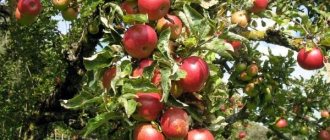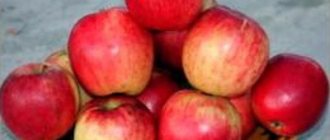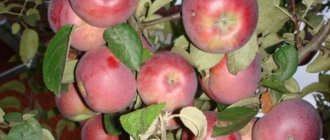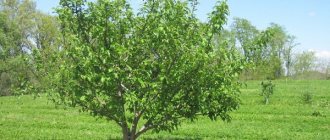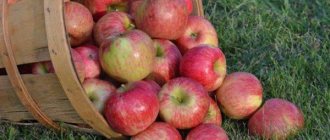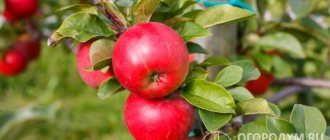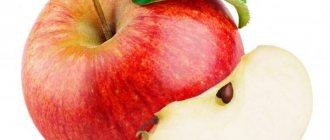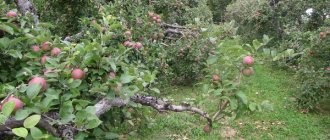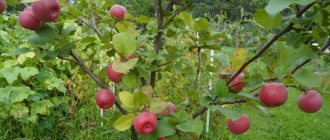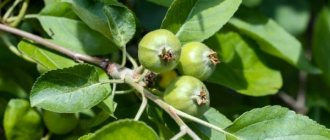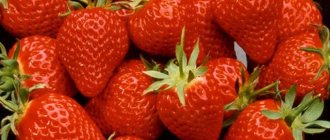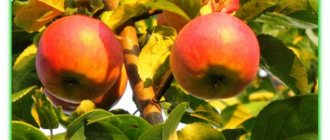Choosing one variety or another is, at first glance, a simple matter. But when you touch this issue personally, then in reality not everything is as simple as it seems.
At the present stage of human development, breeders around the world have developed quite a lot of varieties of apple trees.
In addition to apple trees with normal characteristics, dwarf and columnar apple trees have also been bred. Each of which has its own care features and characteristics.
And in order to choose the right variety, you must first read the description of apple tree varieties , only then make a choice of one or another apple tree:
- First of all, you need to pay attention to the winter hardiness of the tree . Since it is winter hardiness that plays an important role not only for successful overwintering, but also for the formation and ripening of a good harvest;
- An important characteristic of the apple tree is also resistance to diseases and pests. If the tree is planted in an unsuitable climate, such as too wet or cold, the apple tree may become susceptible to pests and diseases.
Thus, the tree will simply not have time to recover after wintering or illness, and one can forget about a good harvest; - the yield of the variety as equally important . For many gardeners and hobbyists, this indicator is the main one when choosing a variety;
- The taste of the fruit is also considered one of the main criteria. Moreover, recently there are many varieties of apples with a universal purpose. Those. these are the fruits that can be used not only for fresh consumption, but also for making jam, marmalade, and dried fruits;
- You also need to download about the shelf life of fruits . The choice of variety will also depend on the shelf life of the fruit. Using this indicator, you can predict your reserves for the winter period. After all, some apples can be stored until the next season.
Attention! To avoid making a mistake in this matter, you need to familiarize yourself with the description and main characteristics of the varieties.
Description, photo of the Champagne variety
The Champagne apple tree is one of the best large-fruited varieties . The apples are quite large. The maximum weight can reach 120 -140 grams. The average fruit weight is 100 grams . Apples with a round and sometimes conical shape. The color is yellow, red shades in the form of streaks are often observed. The pulp is juicy and white. It has a sweet and sour aftertaste.
Apples ripen at the end of September and do not have a long storage period. If all storage requirements are met, they can last approximately 25 to 30 days.
The tree has high winter hardiness . But it can often be damaged by bright direct sunlight.
Champagne yields are good and annual.
Apple tree Champagne.
Apple tree variety Renet Champagne
Apple tree variety Renet Champagne
Synonym: Paper renet. An old winter apple variety, Renet Champagne, of Western European origin.
It appeared in our country at the beginning of the 19th century and was introduced to the Caucasus and Central Asia. The tree is of medium thickness, has a wide, flat-rounded dense crown. The leaves are broadly elliptic, large, dark green.
The fruits are of medium and above-average size, weighing 100-150 g, flat-spherical in shape, with wide smoothed ribs, as if dividing the fruit into five segments. The main color of the fruit is pale waxy yellow; cover - pink-red, blurred on the sunny side. The skin of the fruit is thin, dense, and greasy to the touch when stored. The pulp of the fruit is white, dense, crispy, when ripe it becomes juicy and loose, sweet-sour taste, without aroma, of average quality; contains up to 11.0% sugars and up to 0.5/" acids.
The period of fruiting begins in the sixth to eighth year after planting; produces abundant harvests, sometimes over 1000 kg per tree. The fruits are held on the tree very firmly, in bunches. Pick-up time: end of September; it lasts longer in storage than all other varieties, and in very good condition; in May they look as if they had just been taken from the tree - they do not wither, do not wrinkle, and are easily transported.
Renet champagne blooms late and for a long time. Flowers are little sensitive to frost and can tolerate temperatures as low as -5. The growing season of the tree is very long; often plants meet the winter in a leafy state with unripe shoots.
This variety is quite winter-hardy . As a rule, young trees are more sensitive to frost than middle-aged trees. The variety is quite resistant to diseases and pests; it is rarely attacked by the codling moth. Works well on rich, deep and fresh soils; It bears little fruit on dry and light soils. The range of the variety is wide - the southern and southwestern regions, the North Caucasus and Transcaucasia, Central Asia, especially Uzbekistan.
The best pollinators of Renet champagne: Winter golden Parmen, White Rosemary, Renet Simirenko, Pepin London, Sary sinap, Renet Landsberg, etc. In turn, Renet champagne pollinates well the varieties Winter golden Parmen, White Rosemary, Renet Simirenko, Boyken, Renet Orléans, Sary sinap, Renet landsberg, etc. According to the 1962 census, Renet champagne ranks second after Sarah sinap - 13.9/.
In areas with fertile soil, protected from the winds, in good nutrition and irrigation conditions, it achieves powerful development, produces high yields and easily switches to annual fruiting (Victory state farm, Nizhnegorsky district, etc.). In poor conditions, trees are more damaged than others by sunburn and often freeze; in summer they suffer from dry winds; bear fruit periodically.
additional characteristics
Advantages and disadvantages
The advantages of the variety include:
- Good frost resistance. The tree tolerates winters with low temperatures well;
- Easily tolerates night temperature changes;
- Has a good level of disease resistance;
- Recovers quickly after defeat or damage.
The variety does not have a very long fruit storage period. This can be attributed to the disadvantages of this variety.
Another disadvantage is that the tree is highly susceptible to damage from spring sun rays.
Mature tree height
The tree has a medium-sized crown and not very long branches. The height of an adult tree is about 4.5 - 5 meters.
With such a tree height, it is not very easy to care for an apple tree. Therefore, with proper pruning and shaping, a compact tree can be formed.
You can achieve a tree height of 3.5 to 4 meters. This height of the tree will significantly reduce labor costs and make harvesting easier.
Frequency of fruiting
After entering the fruiting period, the apple tree produces a harvest every year . Usually this period begins from the fifth to sixth years.
Annual growth
During the year, shoot growth for a medium-sized tree ranges from 55 to 60 centimeters. If this indicator is below the specified limit, then the apple tree was most likely damaged by pests or diseases.
Also, this situation may be associated with poor overwintering and frost damage. Since after this the tree needs to spend energy and nutrients on tissue restoration.
Sometimes the growth can be higher than 60 centimeters . This may be due to improper feeding. An excess of nitrogen fertilizers gives a significant increase in green mass. But if the shoots do not have time to ripen before the arrival of severe frosts, the shoots may freeze. So here it is necessary to follow the norm.
Annual shoot growth.
Productivity
Has average performance. Among the varieties of its group, it ranks first in terms of yield in the lists.
Tasting assessment
4.6 points. The fruit makes a very tasty apple charlotte. You can also make apple jam, jam, compote and dried fruits from the fruits. In addition, the fruits are very useful when consumed fresh.
Winter hardiness
The apple tree has a high level of winter hardiness. In areas with harsh winters, it tolerates fairly low temperatures.
Sometimes it receives minor damage in the form of frost holes. But the apple tree has good restorative ability.
During the initial period of sap flow and bud opening, damage quickly heals and this has almost no effect on the active development and growth of the tree.
Main characteristics of the variety
To decide whether a Champagne apple tree is suitable for growing in the garden, you should familiarize yourself with the main characteristics and features of this tree.
Dimensions
The trees themselves reach great heights - up to 5 meters. If you do not form a crown from the very beginning and allow the apple tree to grow on its own, then you may end up encountering difficulties in caring for it.
The ripe apples themselves weigh on average 100 grams, but there are also large specimens reaching up to 150 grams.
Productivity
The productivity of this type of apple is high: among all varieties of apple trees in this group, the Champagne variety occupies one of the leading positions. This is a priority for many gardeners, especially if the crop is grown for sale.
If the spring turns out to be warm and sunny, then the harvest will be better and larger than if there was a lot of rain and wind. Productivity also increases due to pollination of the tree by insects or other apple trees.
Frequency of fruiting
With proper care (timely watering, fertilizing and feeding, forming the tree crown and protection from pests), the apple tree will bear fruit every year. The first apples appear, as a rule, no earlier than the 3-5th year of tree growth.
The apple tree begins to bloom towards the end of spring and continues until about the tenth of June. The fruits ripen in early August and until early September.
Reviews
Valentin. “The Champagne apple tree is quite unpretentious. The tree requires virtually no maintenance. It has good winter hardiness, and has never frozen in my garden. Although there were quite severe winters. The apple tree bears fruit every year. But the fruits do not last long. The apples taste very good. The whole family is happy. I think that this variety is simply necessary for every family.”
Oksana . “The variety has been growing on our family plot for a long time. Apple tree with good frost resistance. Has strong immunity. Even with massive casualties. You can make very tasty dishes from apples, as well as very tasty freshly squeezed juice. The taste is excellent. With this variety, the family will always be enriched with vitamins.”
Artem. “I have been growing a tree of this variety for several years. I bought it after seeing a photo and description of the variety on the Internet. It has already begun to bear fruit. The first apples formed in the fourth year. Although, on average, fruiting begins only in the fifth year. Only a few fruits are ripe on the tree. According to the description of the variety, they write that the yield is good, and apples can reach two hundred grams. The fruits are beautiful and tasty. I would recommend this variety to other families.”
Apple tree, Malus
Aborigine
The summer variety was bred at the Far Eastern Research Institute of Agriculture by A.V. Bolonyaev from crossing Av.
Vanguard
The autumn variety was bred at the Far Eastern Research Institute of Agriculture by A. V. Bolonyaev from pollination in 194.
Augusta
A late-summer triploid variety was obtained at the All-Russian Research Institute for Breeding Fruit Crops from crossing Orlik x Papirovka in 1982.
Augustovskoye Far Eastern
The variety was obtained by A.V. Bolonyaev at the Far Eastern Research Institute of Agriculture from pollination in 1937 Ra.
Adyghe
Late winter variety bred by the North Caucasus Research Institute of Mountain and Foothill Horticulture. Obtained from crossing Golden Delicious x Red.
Idared
American variety (Wagner x Jonathan), winter or late winter ripening. Zoned throughout the south of Russia, in Ukraine. ABOUT.
Alyonushka
The summer variety was bred at the Krasnoyarsk Experimental Station of Fruit Growing by N. N. Tikhonov and A. S. Tolmacheva from crossing the Laleti ranetki.
Alyonushkino
Summer apple tree variety of intensive selection type, North Caucasus Zonal Research Institute of Horticulture and Viticulture. Obtained from crossing.
Alpek
The late summer variety was obtained at the Scientific Research Institute of Horticulture of Siberia named after. M. A. Lisavenko from crossing in 1975 with.
Altai pigeon
The summer variety was obtained at the Scientific Research Institute of Horticulture of Siberia named after. M. A. Lisavenko by crossing in 1937 Ranet.
Altai crimson
The autumn variety was obtained at the Scientific Research Institute of Horticulture of Siberia named after. M. A. Lisavenko from pollination in 1963 of Ranetka Er.
Altai velvet
The autumn variety was obtained at the Scientific Research Institute of Horticulture of Siberia named after. M. A. Lisavenko from crossing in 1948, selected.
Apple tree (lat. Mālus) is a genus of deciduous trees and shrubs of the Rosaceae family with spherical sweet or sweet and sour fruits. Comes from the temperate climate zones of the Northern Hemisphere. The catalog contains 316 varieties of apple trees. You can view a photo illustration and description of varieties included in the State Register of Breeding Achievements and approved for use.
Features of planting and care
Landing
In order for the apple tree to take root well, it is necessary to plant correctly:
- First you need to dig a hole from 80 centimeters to one meter deep. The depth will depend on the size of the root system;
- An iron stake is dug into the center of the hole, to which the seedling is fixed;
- They also make a small mound of soil in the center, on which the root system expands;
- After this, you need to cover the seedling with soil and water it well;
- After the soil has settled, you need to add more soil and water again;
- Also mulch the tree trunk of the seedling to preserve soil moisture.
Deadlines
The best time for planting and better survival of the seedling is spring. It is necessary to have time before the buds open. Typically this period starts from the end of April to mid-May. If you do not have time to plant during this period, the seedling will slow down its growth a little.
Distance
The distance between trees is standard. Planting pattern 4.5 by 3.5. The distance between apple trees will be approximately 4 to 4.5 meters. And the distance between rows in the garden is from 3 to 3.5 meters.
Distance when planting an apple tree.
Agricultural technology and cultivation
Apple tree agricultural technology includes:
- Proper watering - 3-4 times per season;
- Fertilizing with mineral and organic fertilizers, possibly complex;
- Formation and pruning of the crown;
- Protection from diseases and pests.
Important! The Champagne apple tree variety has no special care requirements. She needs the same care as other apple trees.
Pruning and crown formation
Typically, sanitary pruning is always used . It must be carried out in early spring and throughout the growing season. During sanitary pruning, old and dried branches are removed, as well as branches that grow deep into the crown. Damaged or infected branches are also removed down to healthy tissue.
The crown is most often formed as a sparsely tiered crown. With this formation, the number of fruiting branches is normalized. In this way, it is possible to achieve annual fruiting, even if the apple tree has a dormant period. Also, with this formation, sun rays and air pass well into the tree crown. The tree will hurt less and grow and develop better.
Sparsely tiered crown shape.
Pollination
This variety has an average level of self-fertility. If the weather was good during the flowering period, the apple tree will be well pollinated. But if there was heavy rain or wind, this can significantly affect the yield.
In addition, yields can increase significantly due to pollination with other varieties of apple trees .
Apple tree “Splash of Champagne”: characteristics and description of the variety, cultivation and care, photo
In the garden, the main place is often given to apple trees. Not surprising, because they have been grown by humans since ancient times, their fruits are tasty and can be used to make various preparations. Let's get acquainted with the variety of apple trees "Splashes of Champagne", with its main characteristics and a description of how to plant and care, collect and use the fruits.
Botanical description and characteristics of the apple tree
The apple tree variety “Champagne Splashes” is very similar to the “Livlyandskoe Champagne” variety, from the same variety group, but still has its own characteristic features.
Characteristics of fruit and tree
The apple tree of the “Champagne Splash” variety grows up to 4.5–5 meters without shaping and has average crown size parameters with long branches. Enters the fruiting phase at the age of five to six.
The tree winters well, but too severe frosts can leave frost holes on it, which quickly heal in the spring and do not particularly affect the yield. Flowering - from late May to early June. The harvest ripens in mid-summer.
The rounded fruits are large in size, greenish in color with red splashes. Apples have juicy white flesh with a pleasant sweet and sour taste. Tasters rated them 4.6 points. The average weight is approximately 100 g, but some specimens reach 200 g.
Apples can be stored for no more than 30 days, even under optimal conditions. Therefore, they are best eaten fresh or processed. Suitable for drying, making jam and compote, preparing baked goods and other dishes.
Pros and cons of the variety
- The advantages of the “Champagne Splash” variety include the following:
- good frost resistance and endurance;
- disease resistance;
- stable yield;
- excellent taste;
- versatility of fruit use.
- The disadvantages include:
- fruits are not stored for a long time;
- sensitivity to spring rays, which leave burns on the apple tree bark unprotected by whitewashing.
Pollinators
This apple tree has an average level of self-fertility. The presence of pollinators and good weather during flowering significantly increases the number of ovaries. Therefore, it is recommended to plant pollinating varieties next to it and attract bees to the garden.
It is best to choose a variety for pollination that blooms at the same time and bears fruits that can be stored through the winter. Of course, without these measures there will also be a harvest, but not as much as it could be. Varieties such as “Cinnamon Striped” or “Pobeda Chernenko” can be used as pollinators.
Productivity
Gives average yields, but is stable. In good conditions, 170 kg of apples can be harvested from one mature tree.
Features of planting and caring for an apple tree
The “Champagne Spray” apple tree variety does not require special care, but in order to get good harvests, you need to follow certain agrotechnical practices.
Landing rules
It is better to plant a seedling in the spring, in April-May, before the buds open. The technology for planting an apple tree is no different from planting any other fruit tree.
In order for the seedling to take root well, you need to adhere to the following sequence:
- Dig a hole 0.8–1 m deep. Usually it is prepared 1–2 months before planting. It is also necessary to prepare the soil for planting. To do this, fertile soil is mixed with rotted manure, at the rate of 20 liters per 1 tree. 1 kg of wood ash and superphosphate are also added here.
- Place an iron peg in the center of the recess to secure the tree.
- Sprinkle a little prepared soil on which to place the seedling, carefully straightening the root system;
- Then the seedling is covered with soil and watered abundantly.
- When the ground settles, it is necessary to add more soil and moisten it again.
- It is advisable to mulch the soil around the seedling so that the soil does not dry out.
Selecting the best seedlings for planting
An annual seedling has a height of 1.2–1.3 m. If it is lower, this indicates improper cultivation of planting material. You should pay attention to the root system. When cut, the roots should be moist and light in color, without signs of rot or growths. There should be no visible damage on the trunk; it must be smooth, without signs of pests and diseases.
The root system of a good seedling has branches and many small roots. If there is only one root, without branches, or the roots are broken, you should refuse such a purchase. A 2-year-old seedling should already have evenly spaced branches.
Choosing a landing site
You need to choose a place for the apple tree that is sufficiently illuminated by the sun and open, but protected from the north wind. Groundwater should not come closer than 2.5 m to ground level. Well suited with fertile and neutral soil, without stagnant water.
Apple trees tolerate slight acidification, but if the acidity of the soil at the planting site is increased, then it is necessary to add dolomite flour or lime when digging the soil.
Important! Phosphorus-containing fertilizers are not compatible with lime, so liming of the soil is carried out 30 days before applying fertilizers.
Salt marshes also harm its development. This tree is completely unsuitable for wetlands, dry sand, or too dense clay or rocky soil. If the soil is unsuitable, you need to completely change the soil in the pit to fertile soil. The best soil mixtures are chernozems, sandy loams and loams.
Planting scheme
The planting pattern for apple trees of this variety is 4.5 × 3.5 m. The gaps between trees will be 4–4.5 m, and between rows – 3–3.5 m. This distance must be maintained so that the trees do not shade each other.
Watering and fertilizing
Over the entire season, it is necessary to water the apple orchard at least 3 times:
- immediately after flowering;
- during the period of fruit formation;
- last watering after harvest. This will prepare the tree for the winter, but if the weather is rainy in the fall, then moisturizing may not be necessary.
After each watering, the soil should be loosened to improve the flow of air and moisture to the root system. In hot and dry weather, unscheduled humidification is necessary.
It is necessary to pour about 6–9 buckets for the entire season under 1 adult tree.
To moisturize, you can choose the method of sprinkling, drip irrigation, as well as adding water to small grooves dug around the tree, after which they are leveled.
Important! It is not worth watering trees under pressure, from a hose, as this will compact the soil around them. And as a result, the supply of moisture, nutrients and oxygen to the roots of the apple tree will decrease.
To obtain a high yield of apples, it is necessary to apply fertilizing in a timely manner. After planting a young seedling, fertilization is carried out only after 2 years. To do this, in the spring, urea is added to the soil at the rate of 1/2 tbsp. spoons per 1 m². Urea can be replaced with nitrate, but in this case, the application rate should be doubled.
During this period, it is good to fertilize the area around the apple tree with wood ash, at the rate of 0.5 liters per 1 m². To improve soil fertility, you can plant greens near apple trees - lupine, alfalfa, clover, white mustard.
Before winter, these plants are well placed in the ground as mulch. In the fall, it is recommended to apply superphosphate, rotted mullein or bird droppings, wood ash, and potassium chloride from mineral fertilizers around the tree trunks.
To increase the yield, it is recommended to carry out foliar feeding. For this purpose, spray with a urea solution at the rate of 3 g per 1 liter of water. The rate of fertilizer application depends on the composition of the soil and how closely the trees grow to each other. On average, there are 3–12 g of each element (nitrogen, phosphorus, potassium) per 1 m².
Trimming methods
Pruning is carried out every year. The process itself is carried out in early spring before the buds open, and in the fall, when the entire harvest is harvested.
Formative pruning is carried out the next year after planting a young seedling. Four strong branches are left, which are located at the same distance from each other, and the rest are removed. In March-April, before the fruit buds swell, the elongated branches are pruned.
Basically, the crown is formed as a sparse-tiered one.
This form of pruning allows for control of branches for fruiting. Thanks to this procedure, you can harvest apples every year, avoiding a dormant period. Excessive density of the crown is eliminated and the tree is better illuminated by the sun, which means it is less susceptible to disease and develops better.
When caring for an apple orchard, sanitary pruning is used. It is done at the beginning of spring, as well as throughout the growing season. During this process, dried and disease-affected branches are removed. It is necessary to trim branches that grow inward.
When a lot of fruit buds are laid, in order to obtain a high-quality harvest, normal pruning is carried out - part of the shoots is removed for fruiting. If there are few fruit buds on the tree, then this procedure is not done. It is necessary to regularly carry out anti-aging pruning - branches with old buds are removed annually, since the fruits on them will form small.
Important! Branches and shoots should be pruned so that no stumps remain. The cut area is treated with garden varnish.
Whitewash
In early spring, the trunk and main branches are whitewashed with lime mortar to repel insect pests. In the winter, it is imperative to carry out a similar procedure in order to repel rodents.
Preparing for winter
In late autumn, apple tree trunks are whitened with lime. On old trees, the top layer of bark is removed, since pests hide under it for wintering, and various infections and fungi accumulate. The soil around the trunks should be dug up so that the larvae of various pests do not survive the winter.
To protect against frost, the soil is mulched. Mullein, peat, and humus are used as mulch. The trunks are wrapped from the cold and to protect against rodents with pieces of roofing felt or spruce branches are used.
Diseases and pests
To obtain a guaranteed apple harvest, it is necessary to promptly identify diseases and pests in order to take appropriate measures to eliminate the problem.
The apple orchard is often exposed to the following diseases:
- Powdery mildew . It appears as a whitish coating, which over time becomes brown with small dark dots. In this case, it is necessary to cut off all affected parts of the trees. At the initial stage of the lesion, sulfur (80 g per 10 l) or sulfur-containing preparations helps well.
- Fruit rot . This fungal disease manifests itself in the form of brown spots on the fruits, on which, after a while, whitish circles appear. The apples dry out and fall off. Such carrion must be collected and disposed of. To treat fruit rot, spray with 1% Bordeaux mixture.
- Scab . Signs of the disease are that the leaves turn brownish and then begin to dry out. Small brown spots can be seen on the fruits. Treatment consists of spraying with Bordeaux mixture. The first treatment is carried out with a solution of 3% concentration at the time of bud break. The second spraying is carried out after the apple tree has bloomed, with a solution with a concentration of 1%. The third treatment is 14-21 days after flowering with Horus or Ditan.
Let's look at the main insect pests:
- Hawthorn . This moth with whitish wings lays eggs on tree leaves. The caterpillars that emerge from such clutches feed on the juice of leaves and fruits. To combat hawthorn and its larvae, trees are sprayed in the spring with chemicals such as Karbofos, Phosfamide, Metaphos.
- Hawthorn moth . The larvae of this insect also drink juice from the leaves. To destroy pests, treatments are carried out at the beginning of flowering with a Karbofos solution.
- Winter moth . This butterfly appears closer to autumn and lays eggs. In the spring, larvae appear, which during the flowering period begin to feed on flowers and leaves. Pests are destroyed by using the chemical preparation “Karbofos”.
- Tick . This pest feeds on leaves, damaging them. In winter, it hides in the bark. Therefore, to combat mites, bark on old trees must be removed and disposed of. To destroy the pest, insecticidal preparations such as “Karbofos” and “Kleschevit” are used.
- Aphid . This small pest drinks the juice of the leaves, on which, as a result of its activity, a coating appears. For control, insecticidal preparations are used or treatments are carried out with a solution of tobacco dust or soap.
Professional gardeners recommend taking preventive measures against the appearance of pests and diseases:
- loosening the soil under trees, removing weeds;
- dig up the earth, especially for the winter;
- use special catching belts and traps that are fixed to the trunk and branches of a tree;
- removal of vegetation residues and fallen leaves in autumn;
- pruning disease-affected branches and treating the cut areas with garden varnish;
- to reduce the risk of fungal diseases, it is necessary to remove and dispose of carrion from under the trees;
- carry out preventive treatments with Bordeaux mixture and copper sulfate in early spring and autumn, in preparation for wintering;
- Carry out regular garden inspections to identify pests and diseases so that appropriate measures can be taken in a timely manner.
Harvest and storage
The “Champagne Splash” variety of apples is harvested starting in mid-summer. For storage, it is better to use wooden boxes, the bottom of which is lined with paper. The optimal temperature for storage is from 2°C to 5°C, humidity 85-95%. Apples of this variety are not stored fresh for long - up to 30 days.
The apple tree variety “Champagne Splashes” produces stable yields of tasty and juicy greenish-red fruits of large size. Unfortunately, they cannot be stored for long, but they are perfectly suitable for processing. Although the variety is capable of setting fruit on its own, the presence of a nearby pollinator significantly increases the yield.
Source: https://fermer.blog/bok/sad/plodovye-derevya/yabloni/sorta-yablon/letnie-sorta-yablon/5589-jablonja-bryzgi-shampanskogo.html
Features of ripening and fruiting
Beginning of fruiting
When the seedling reaches the age of 5–6 years, the first fruits ripen on the tree.
Deadlines
Blooms
Flowering occurs approximately from the last ten days of May to the first ten days of June.
Apple tree blossom.
Maturation
Apples ripen in late summer. By the beginning of September.
Harvest storage
The fruits do not last long . In order for fruits to be stored for a long time, it is necessary to observe temperature conditions, as well as air humidity. Under these conditions, apples can be stored for up to 30 days.
Reviews from gardeners about the apple tree
Valentin, Belgorod: “The Champagne apple tree has been growing here for a long time. It produces a harvest every year, easily survives even cold winters, and is unpretentious. The fruits are tasty, but do not last long. What we don’t have time to eat or sell goes for conservation.”
Oksana, Nizhny Novgorod: “More than one tree of this variety grows on the family plot. The taste is amazing, the apples are beautiful. It is characterized by extraordinary resistance to diseases. We are glad".
Artem, Perm: “I bought a tree after seeing a photo on the Internet. I received my first harvest already in the 4th year. The tree easily survives winters and temperature fluctuations. I recommend".
In the garden, the main place is often given to apple trees. Not surprising, because they have been grown by humans since ancient times, their fruits are tasty and can be used to make various preparations. Let's get acquainted with the variety of apple trees "Splashes of Champagne", with its main characteristics and a description of how to plant and care, collect and use the fruits.
Apple tree Champagne
Rennet
Another name is Ranet Paper (Winter Champagne) . The crown is dense, slightly round.
The mass of apples reaches 150 grams. The color is waxy yellow with a reddish tinge.
The harvests are plentiful. Good frost resistance.
Varieties for pollination and obtaining a more abundant and high-quality harvest:
- Rosemary White;
- Ranet Simerenko.
Important! The tree does not require special care.
Spray
Trees of this variety have a mid-summer ripening period.
The tree does not grow much. The crown of the apple tree has fairly long and spreading branches. Has good frost resistance.
The fruits are usually round and regular in shape. The weight of apples is large in comparison. The average weight is 100 grams, and the maximum weight is two hundred grams. The color of the fruit is often green. Sometimes red blotches show through.
Livlyandskoe
In this section we will show how the Livlyandskoye Champagne apple tree differs: description and photo.
This variety has abundant and good yields. Has decent frost resistance. Apples can be eaten at the end of the summer. Usually this moment occurs in August.
The tree is massive, shoots and branches are long. The color is green, with red spots appearing.
The average fruit weight is 120 – 140 grams.
Crimean
This variety has almost all the same characteristics as Liflyandsky and Spray Champagne. Good frost resistance, abundant annual yield.
Description of the variety
This is one of the most successful varieties for growing in your own garden. The fruits grow large - on average 100 grams. Some can reach 150 grams. The ripe fruits are predominantly round in shape. When ripe, apples of this variety are light yellow in color with red spots or “blush”.
The description of this type of fruit says that such apples are juicy and have a dense texture. The skin may have a characteristic waxy coating. The fruits have a sweet-sour taste, and during ripening the sour taste becomes less.
Subspecies of the variety:
- Ranet champagne;
- Splashes of champagne;
- Livland champagne;
- Crimean champagne.
Favorable regions for growing
The most favorable regions for cultivating this variety include most regions of the country, since the Champagne apple tree variety has good characteristics for cultivation. The variety feels good in central Russia.
Siberia
Siberia is characterized by harsh climatic conditions. It is characterized by fairly low temperature conditions. Champagne grows well here. This variety is saved by its high winter hardiness and rapid ability to recover from damage.
In Siberia, it is necessary to cover apple trees for the winter.
Advice! In winter, it is recommended to cover the tree trunk with covering material, as well as cover it with snow.
Best Growing Regions
Due to their characteristics, apples of this type take root in most regions of Russia, but the best place for cultivation is the central zone. Trees of this type are often planted in Siberia, despite possible extreme temperature conditions - Champagne apples are winter-hardy and can quickly recover if damaged.
Botanical description and characteristics of the apple tree
The apple tree variety “Champagne Splashes” is very similar to the “Livlyandskoe Champagne” variety, from the same variety group, but still has its own characteristic features.
Characteristics of fruit and tree
The apple tree of the “Champagne Splash” variety grows up to 4.5–5 meters without shaping and has average crown size parameters with long branches. Enters the fruiting phase at the age of five to six.
The tree winters well, but too severe frosts can leave frost holes on it, which quickly heal in the spring and do not particularly affect the yield. Flowering - from late May to early June. The harvest ripens in mid-summer.
The rounded fruits are large in size, greenish in color with red splashes. Apples have juicy white flesh with a pleasant sweet and sour taste. Tasters rated them 4.6 points. The average weight is approximately 100 g, but some specimens reach 200 g.
Apples can be stored for no more than 30 days, even under optimal conditions. Therefore, they are best eaten fresh or processed. Suitable for drying, making jam and compote, preparing baked goods and other dishes.
Description of the apple tree
The apple tree is a tree up to 14 meters high, with falling whole leaves. The fruit is apple-shaped with five seed chambers, each containing two seeds.
About 35 species have been described in the Northern Hemisphere. Apple fruits contain 12 - 15 percent sugars, 3.7-4.1 malic acid, 0.09-0.13 percent citric acid, 0.43-1.20 percent pectin, vitamin C is contained in small quantities. The lifespan of apple trees is 30 - 100 years. People have been eating wild apples since ancient times; domesticated apples came from the territory of modern Kazakhstan. Propagated by grafting onto a rootstock grown from seeds of wild forest and cultivated apple trees. A cultivated apple tree requires sufficiently moist, deep, breathable soils. The best soils are considered to be slightly podzolized, dark gray and gray soils of deciduous forests. The size of the fruit depends on the variety of apple tree. Red, yellow, green apples can be eaten raw, and they can also be used to make jam, compotes, and dried apples. They are baked and prepared with different fillings.
